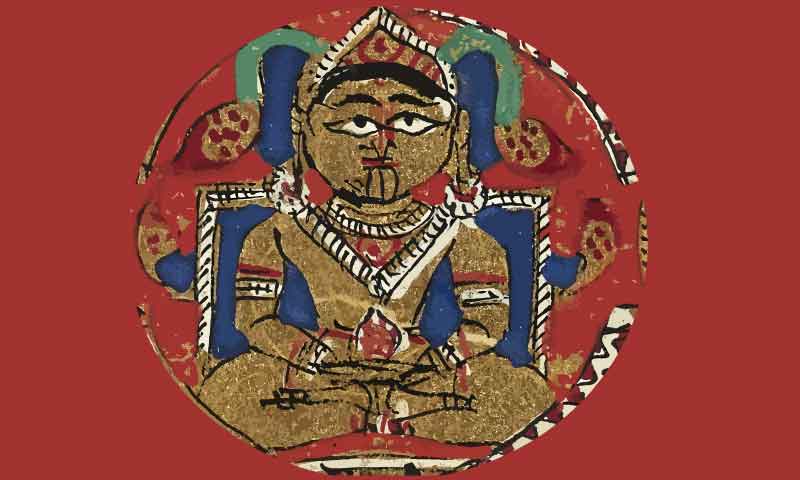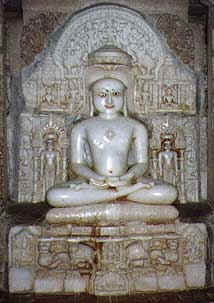
Jain Tirthankaras

The concept of thirthankara is peculiar to Jainism. A tirthankara is a religious teacher who has been freed from the bonds of karma and crossed the world of transmigrations. Through his teachings and personal example, he makes it his central objective to help mankind achieve nirvana or salvation.
Jain tradition recognizes 24 Tirthankaras who propagated the religion during their existence upon earth, after receiving enlightenment through severe austerities and ascetic practices. The last of the Tirthankaras was Vardhamana Mahavira who succeeded Parsvanatha, the 23rd thirthankara, and made Jainism popular in the Indian subcontinent by reviving many of its ancient traditions and practices. The Tirthankaras constitute the Jain pantheon.
Although Jainism is an atheistic religion, followers of Jainism worship the statues, icons, images and symbols of the Tirthankaras in temples and homes seeking their blessings and intervention for liberation.
A thirthankara is not a god, but an enlightened and perfect being who has been rendered by his previous karma to be a source of knowledge and enlightenment to others. He is higher than the gods of Jainism.
The Tirthankaras appear in certain periods of human history to redeem people from the cycle of births and deaths by teaching them the doctrine of Jainism. Followers of Jainism believe that in each artha kalpa (half time cycle) 24 Tirthankaras manifest upon earth.

The Tirthankaras manifest not only upon earth, but in several other worlds that exists in different parts of the universe. The Digambara Jains believe that all the Tirthankaras who were born in this time cycle are men, while the Svetambaras believe that of the 19th thirthankara was a woman named Mallinath.
Some of the Tirthankaras such as Mahavira,Parsvanath and Rishabhanath are confirmed historical personalities. In their icons the Tirthankaras are usually depicted as either seated in lotus position or standing.
The Digamabaras depict them without clothes while the Svetambaras show them decorated with clothes and ornaments. Parsvanatha, the 23rd thirthankara is usually shown in the company of snakes or overshadowed by a snake hood.
Rishabhanatha
Rishabha, also known popularly as Adinath, was believed to be a historical person, born to King Nabhi Raja and Queen Marudevi at Ayodhya in the Ikshvaku clan. P. C. Roychoudary puts the date of Risabha at the end of Stone Age and beginning of the agriculture age. Some historians like Ramprasad Chandra, John Marshall, suggested that Rishabhanatha was known to Indus valley people and worshipped by them.
According to Jain legends, Rishabh existed in prehistoric times before the development of human civilization. As the first knowledgeable person, he said to have taught the mankind agriculture, animal husbandry, art, architecture, music, dance, criminal justice and many other branches of knowledge and arts and crafts.
With the blessings of his father Nabhiraja, he assumed the responsibilities of a king and introduced a social order based on virtues and profession, dividing the society into merchants, warriors and workers, a system that was subsequently adopted by the vedic people with suitable modifications. Vinita or Ayodhya was his capital.
He had several sons, of whom the eldest was Bharata who became the first emperor of ancient India. Bahubali was his another son, whose mammoth statue now stands at Shravanabelagola in Karnataka and worshipped by millions of Jains. Some Hindu Puranas mention the name of Rishabhanath. According to the Bhagavata purana, Rishabha was an incarnation of Lord Vishnu.
Ajitnatha
Ajitnatha, the second Jain Tirthankara, was born to King Jitashatru Raja and Queen Vijaya at Ayodhya in the same Ikshvaku clan in which Rishabha and Lord Rama were born. He received enlightenment after performing severe austerities under the guidance of Arindam Suri. One of his brother's name was Sagara, who according to some, was the father of sage Bhagiratha who was responsible for the descent of the Ganges on to the earth through his penances.
The list of the 24 Tirthankaras with their associated details are shown below.1
| Tirthankar | Heaven | Birthplace; Consecration |
Parents | Complex | Symbol | Tree | Attendant spirits |
Male disciple; Female disciple |
|---|---|---|---|---|---|---|---|---|
| I. Lord Rishabha (Adinath) | Sarvarthasiddha | Vinittanagari; Purimatala |
Nabhiraja by Marudeva |
golden | bull or ox | Vata (banyan) | Gomukha and Chakresvari |
Pundarika; Brahmi |
| II. Ajitnath | Vijayavimana | Ayodhya; Sammet Shikharji |
Jita['s]atru by Vijayamata |
golden | elephant | ['S]ala (Shorea robusta) |
Mahayaksha and Ajitabala; or Rohi[n.]i |
Simhassena; Phalgu |
| III. Sambhavanath | Uvarimagraiveka | Savathi; Sravasti |
Jitari by Senamata |
golden | horse | Prayala (Buchanania latifolia) |
Trimukha and Duritari; or Prajnapti |
Charu; Syama |
| IV. Abhinandannath | Jayantavimana | Ayodhya; Sammet Shikharji |
Sambararaja by Siddhartha |
golden | monkey | Priyangu (Panicum italicum) |
Nayaka and Kalika; or Yakshesvara and Vajrasrinkhala |
Vajranabha; Ajita |
| V. Sumatinath | Jayantavimana | Ayodhya; Sammet Shikharji |
Megharaja by Mangala |
golden | curlew or red goose |
Sala | Tumburu and Mahakali; or Purushadatta |
Charama; Kasyapi |
| VI. Padmaprabha | Uvarimagraiveka | Kausambi; Sammet Shikharji |
Sridhara by Susima |
red | lotus | Chhatra | Kusuma and Syama; or Manovega or Manogupti |
Pradyotana; Rati |
| VII. Suparshvanath | Madhyamagraiveka | Varanasi; Sammet Shikharji |
Pratish[t.]haraja by P[r.]ithvi |
golden or emerald |
swastika | Sirisha (Acacia sirisha) |
Matanga and Santa; or Varanandi and Kali |
Vidirbha; Soma |
| VIII. Chandraprabha | Vijayanta | Chandrapura; Sammet Shikharji |
Mahasenaraja by Lakshmana |
white | moon | Naga | Vijaya and Bhrikuti; or Syama or Vijaya and Jvalamalini |
Dinna; Sumana |
| IX. Pushpadanta | Anatadevaloka | Kanandinagari; Sammet Shikharji |
Sugrivaraja by Ramarani |
white | Crocodile | Sali | Ajita and Sutaraka; or Mahakali |
Varahaka; Varuni |
| X. Sheetalnath | Achyutadevaloka | Bhadrapura or Bhadilapura; Sammet Shikharji |
Dridharatha-raja by Nanda |
golden | Kalpavriksha or ficus religiosa |
Priyangu | Brahma and Asoka; or Manavi |
Nanda; Sujasa |
| XI. Shreyansanath | Achyutadevaloka | Simhapuri; Sammet Shikharji |
Vishnuraja by Vishna |
golden | rhinoceros | Tanduka | Yakshet and Manavi; or Isvara and Gauri |
Kasyapa; Dharani |
| XII. Vasupujya | Pranatadevaloka | Champapuri; Sammet Shikharji |
Vasupujya by Jaya |
ruddy | female buffalo | Patala (Bignonia suaveolens) |
Kumara and Chanda; or Gandhari |
Subhuma; Dharani |
| XIII. Vimalnath | Mahasaradevaloka | Kampilyapura; Sammet Shikharji |
Kritavarmaraja by Syama |
golden | pig | Jambu (Eugenia jambolana) |
Shanmukha and Vidita; or Vairo[t.]i) |
Mandara; Dhara |
| XIV. Anantnath | Pranatadevaloka | Ayodhya; Sammet Shikharji |
Simhasena by Suyasah or Sujasa |
golden | porcupine | Asoka (Jonesia asoka) |
Patala and Ankusa; or Anantamati |
Jasa ; Padma |
| XV. Dharmanath | Vijayavimana | Ratnapuri; Sammet Shikharji |
Bhanuraja by Suvrita |
golden | vajra | Dadhiparna (Clitoria ternatea) |
Kinnara and Kandarpa; or Manasi |
Arishta; Arthasiva |
| XVI. Shantinath | Sarvarthasiddha | Gajapura or Hastinapuri; Sammet Shikharji |
Visvasena by Achira |
golden | deer | Nandi (Cedrela toona) |
Garuda and Nirvani; or Kimpurusha and Mahamanasi |
Chakrayuddha; Suchi |
| XVII. Kunthunath | Sarvarthasiddha | Gajapura; Sammet Shikharji |
Suraraja by Srirani |
golden | goat | Bhilaka | Gandharva and Bala; or Vijaya |
Samba; Damini |
| XVIII. Aranath | Sarvarthasiddha | Gajapura; Sammet Shikharji |
Sudarsana by Devirani |
golden | fish or Pisces |
Amba (Mango) |
Yaksheta and Dhana; or Kendra and Ajita |
Kumbha; Rakshita |
| XIX. Mallinath | Jayantadevaloka | Mathura; Sammet Shikharji |
Kumbharaja by Prabhavati |
blue | jar or Kalasa | Asoka | Kubera and Dharanapriya; or Aparajita |
Abhikshaka; Bandhumati |
| XX. Munisuvrata | Aparajita-devaloka | Rajagriha; Sammet Shikharji |
Sumitraraja by Padmavati |
black | tortoise | Champaka (Michelia champaka) |
Varuna and Naradatta; or Bahurupini |
Malli; Pushpavati |
| XXI. Nami Natha | Pranatadevaloka | Mathura; Sammet Shikharji |
Vijayaraja by Viprarani |
yellow; or emerald |
blue water-lily or blue lotus | Bakula (Mimusops elengi) |
Bhrikuti and Gandhari; or Chamundi |
Subha; Anila |
| XXII. Neminatha | Aparajita | Sauripura and Ujjinta (Ujjain); Mount Girnar (Girnarji) |
3 by Senamata |
black | conch | Vetasa | Gomedha and Ambika; or Sarvahna and Kushmandini |
Varadatta; Yakshadinna |
| XXIII. Parshva | Pranatadevaloka | Varanasi; Sammet Shikharji |
Asvasenaraja by Vamadevi |
blue | snake | Dhataki (Grislea tomentosa) |
Parsvayaksha or Dharanendra and Padmavati |
Aryadinna; Pushpachu[d.]a |
| XXIV. Mahavira | Pranatadevaloka | Kundagrama or Chitrakuta; Rijupaluka |
Siddhartharaja, Sreyansa or Yasasvin by Trisala Vidchadinna or Priyakarini |
yellow | lion | teak | Matamga and Siddhayika |
Indrabhuti; Chandrabala |
Suggestions for Further Reading
- The Atomic Theory of Jainism
- History of Jainism
- Jainism - Philosophy and Doctrine
- Major Beliefs of Jainism
- Jain Literature and Canonical Texts
- Jainism Cosmology
- The Jains And Their Creed
- Jainism - Doctrine and History
- An Introduction to Jainism or Jain Dharma
- The Philosophy and Practice of Jainism
- Information Websites on Jainism
- Jainism and the Belief in God
- Jainism - Jivas, the Embodied Souls
- Jainism - Belief in Karma
- The Theory of Knowledge in Jainism
- History of Jainism after Mahavira
- Vardhamana Mahavira
- Jainism - Anekantavada or Nayavada
- An Outsider Perspective on Jainism
- Jainism - Sects and Subsects
- Syadavada or Saptabhangi
- The Tattvas of Jainism
- Jain Thirthankaras
- Ethics of Jainism - The Three Jewels
- Tirthahkaras Before Mahavira
- Essays On Dharma
- Esoteric Mystic Hinduism
- Introduction to Hinduism
- Hindu Way of Life
- Essays On Karma
- Hindu Rites and Rituals
- The Origin of The Sanskrit Language
- Symbolism in Hinduism
- Essays on The Upanishads
- Concepts of Hinduism
- Essays on Atman
- Hindu Festivals
- Spiritual Practice
- Right Living
- Yoga of Sorrow
- Happiness
- Mental Health
- Concepts of Buddhism
- General Essays
1. The table showing Jain Tirthankaras was adopted with some modifications from Wikipedia